Customer communications management—or CCM—is a term that has been making its way into marketing and customer relations circles and conversations lately. But, is it something new, or just a repositioning of the same, classic approach to communication management that marketers have been using for years? Is this a term just used to apply to what is also known as digital marketing, or does it have an analog component as well?
Digital Marketing vs. Customer Communications Management
According to analyst firm Gartner, CCM “is defined as the strategy to improve the creation, delivery, storage and retrieval of outbound communications, including those for marketing, new product introductions, renewal notifications, claims correspondence and documentation, and bill and payment notifications.” The channels, Gartner says, are broad and include both digital and analog forms of communication—everything from traditional documents to short message service (SMS) and web pages.
CCM is nothing new says Kevin Joyce, CMO for The Pedowitz Group (TPG). It’s been around for 30 years and pre-dates digital marketing, he says. “It largely refers to the management and tracking of all outbound customer communications such as bank statements, invoices, etc.” Joyce makes a distinction between digital marketing (“two-way digital communications with prospects and customers to engage them, and ensure they have a great customer experience”) and CCM (a mix of digital and print communications which occurs in one direction). “The intent of CCM communications is not marketing, and more likely to be operational,” he says.
CCM: A Real-World, Recent Example
We can look to the immediate past for some powerful examples of how effective CCM could be put to work in customer communications: the myriad of consumer notices sent out in late May to announce companies’ responses to GDPR—the European Union’s General Data Protection Regulation. How many of the likely missives that arrived in your email box did you feel were brand supportive? How many helped to distinguish one organization from another? How many left you with a warm and fuzzy feeling about the companies behind these messages?
Clearly it is no easy feat for corporations to fit friendly into regulatory-required messages. It is, though, one common form of communication that illustrates the power behind the CCM push and, perhaps, the importance of true communication alignment across all touchpoints.
The Need for Clarity Across all Communications
When it comes to growing interest in CCM implementation, there are really two driving forces at work: the recognition that consumer communication is multi-faceted and occurs through channels separate from the formal marketing function, and the promise that technology may hold to help manage what has previously been considered broadly unmanageable.
To what extent does a difficult to understand billing statement interfere with the “let’s get to the basics” brand identity desired by a global technology firm?
To what extent do terse email responses to customer inquiries negate the “warm and fuzzy” aura a large retailer hopes to convey to its market?
Consumers don’t view messages from marketers in isolation—your GDPR notification email, email marketing offer, and late payment notifications are all part of a whole. All combine to inform every company’s holy grail—a positive brand image.
Technology to the Rescue?
The digital environment, in some regards, represents an opportunity for organizations to better manage all of their interactions with external audiences. While technology has, to a certain extent, led to many of the integrated communication challenges that big brands now face, it may also represent a solution to ensuring consistency in communications across organizational silos.
The right CCM technology can support “the integration of enterprise-wide CCM capabilities with CRM data,” Patrick Kehoe recently wrote in an article for destinationCRM. He points to efforts that notoriously difficult to understand industries—e.g. insurance and banking—are undertaking to drive more positive customer experiences. “An enterprise-wide CCM approach will support plain language rewriters of frequently used content as well as streamlined rules and approval processes that will support compliance and quick time-to-market with relevant content,” he writes.
Of course, despite technology, there remains another eternally vexing impact on the ability of organizations to speak with one voice—people. Consider the many corporate silos likely involved in creating a single GDPR email message: legal, IT, finance, marketing, and others. Consider the conversations required to create a brand-supportive, regulatory compliant, and easy to understand message. There are likely to be a number of internal conversations taking place before external messages can become part of a well-oiled CCM process.






